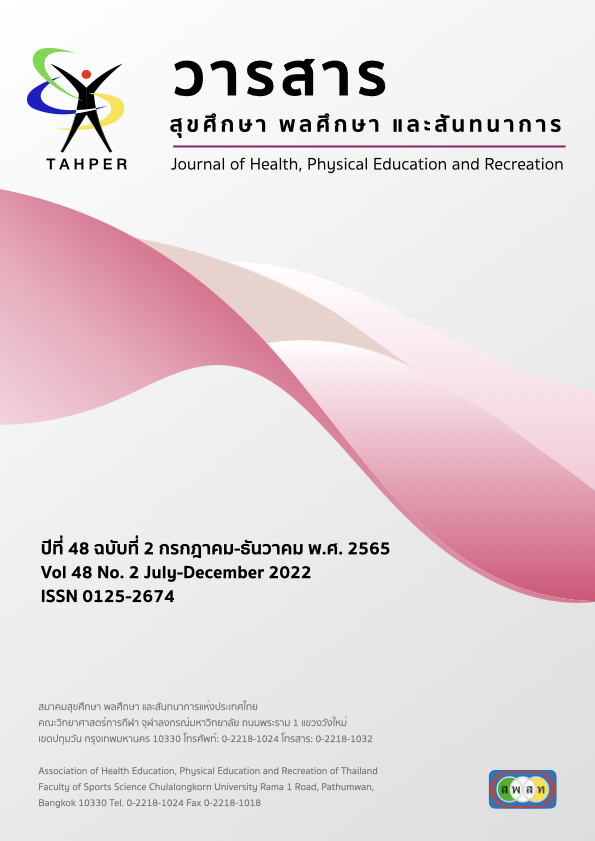การสร้างแบบทดสอบความคล่องแคล่วว่องไวสำหรับนักกีฬาเทเบิลเทนนิส A Construction of Agility Test for Table Tennis Players
Main Article Content
Abstract
บทคัดย่อ
การวิจัยในครั้งนี้มีจุดประสงค์เพื่อสร้างแบบทดสอบความคล่องแคล่วว่องไวสำหรับนักกีฬาเทเบิลเทนนิส กลุ่มตัวอย่างเป็นนักกีฬาเทเบิลเทนนิส รุ่นอายุ ไม่เกิน 15 ปีชาย จำนวน 14 คน ของสโมสรกีฬาเทเบิลเทนนิส ITTI Thailand นำแบบทดสอบที่สร้างขึ้นหาค่าความเที่ยงตรงเชิงเนื้อหา (Content Validity) โดยให้ผู้เชี่ยวชาญ จำนวน 5 ท่าน เป็นผู้ตรวจสอบหาค่าดัชนีความสอดคล้อง (Index of Item-Objective Congruence: IOC) ของ Rovinelli and Hambleton นำแบบทดสอบที่สร้างขึ้นไปหาค่าความเที่ยงตรงตามสภาพ (Concurrent Validity) นำแบบทดสอบที่ผู้วิจัยสร้างขึ้นกับแบบทดสอบมาตรฐาน Edgren Side-Step Test มาคํานวณค่าสัมประสิทธิ์สหสัมพันธ์ โดยวิธีของ เพียร์สัน นำค่าที่ได้ มาพิจารณากับค่ามาตรฐานประเมินสัมประสิทธิ์สหสัมพันธ์ของ Kirkendall หาค่าความเชื่อถือได้ (Reliability) โดยใช้วิธีการทดสอบซ้ำ (Test-Retest) กับนักกีฬาเทเบิลเทนนิส โดยกลุ่มตัวอย่างทำการทดสอบระยะห่าง 1 สัปดาห์ นำผลการทดสอบความคล่องแคล่วว่องไวที่ผู้วิจัยสร้างขึ้น ครั้งที่ 1 กับครั้งที่ 2 มาคำนวณหาค่าสัมประสิทธิ์สหสัมพันธ์ความเชื่อถือได้ โดยใช้วิธีของเพียร์สัน (Pearson-Product Moment Correlation Coefficient) แล้วนำค่าที่ได้มาพิจารณากับค่ามาตรฐานการประเมินสัมประสิทธิ์สหสัมพันธ์ของ Kirkendall
ผลการวิจัยพบว่า
แบบทดสอบความคล่องแคล่วว่องไวสำหรับนักกีฬาเทเบิลเทนนิสมีความเที่ยงตรงตามเนื้อหา ค่าเฉลี่ยมากกว่าหรือเท่ากับ 0.5 เพราะวัดตามวัตถุประสงค์เชิงพฤติกรรมที่ต้องการจริง แบบทดสอบความคล่องแคล่ว-ว่องไวสำหรับนักกีฬาเทเบิลเทนนิสมีความเที่ยงตรงตามสภาพ โดยการนำแบบทดสอบที่ผู้วิจัยสร้างขึ้นกับแบบทดสอบมาตรฐาน Edgren Side-Step Test มาคํานวณหาค่าสัมประสิทธิ์สหสัมพันธ์ของเพียร์สัน ค่าที่ได้เท่ากับ 0.50 ซึ่งอยู่ในเกณฑ์ยอมรับได้ นำผลการทดสอบความคล่องแคล่วว่องไวที่ผู้วิจัยสร้างขึ้น ครั้งที่ 1 กับครั้งที่ 2 มาคำนวณหาค่าสัมประสิทธิ์สหสัมพันธ์ความเชื่อถือได้ โดยใช้วิธีของเพียร์สัน ค่าที่ได้เท่ากับ 0.78 ซึ่งอยู่ในเกณฑ์ยอมรับได้
คำสำคัญ: การสร้างแบบทดสอบ, ความคล่องแคล่วว่องไว, กีฬาเทเบิลเทนนิส
Abstract
The purpose of this research is to create an agility test for table tennis players. The sample group was male table tennis players aged under 15 years old. A total of 14 people from ITTI Thailand table tennis club. First, the test determined the content validity by assigning five experts to verify the index of item-objective congruence (IOC) of Rovinelli and Hambleton. Then, the test determined the concurrent validity. After that, the researcher’s test and the standardized Edgren Side-Step Test calculated the correlation coefficients by Pearson’s method. The value obtained was taken into account with Kirkendall’s correlation coefficients to determine the reliability using the test-retest method with table tennis players. The sample group was tested one week apart. The results from the first and the second tests calculated the
The results found that:
The agility test for table tennis players had a mean content validity greater than or equal to 0.5 because it is measured based on the desired behavioral objectives. The agility test for table tennis players has concurrent validity. The researcher’s test and the standardized Edgren Side-Step Test were used to calculate Pearson's correlation coefficient. The result was 0.50, which is within the acceptable criteria. The results from the researcher's first and second agility tests were used to calculate reliability correlation coefficients by Pearson's method. The result was 0.78, which is within the acceptable criteria.
Keywords: Construction, Agility, Table Tennis
Article Details

This work is licensed under a Creative Commons Attribution-NonCommercial-NoDerivatives 4.0 International License.
Critical thinking in journals is the right of the author. The Association of Health Education, Physical Education and Recreation of Thailand is not always required, to create diversity in ideas and creativity.
ความคิด ข้อวิพากษ์ในวารสารเป้นสิทธิของผู้เขียน สมาคมสุขศึกษา พลศึกษา และสันทนาการแห่งประเทศไทยไม่จำเป็นต้องเห็นชอบด้วยเสมอไป เพื่อให้เกิดความหลากหลายในความคิดและความสร้างสรรค์


